25 Wave Energy Pros And Cons
Check out Every Advantage and Disadvantage of Wave Power
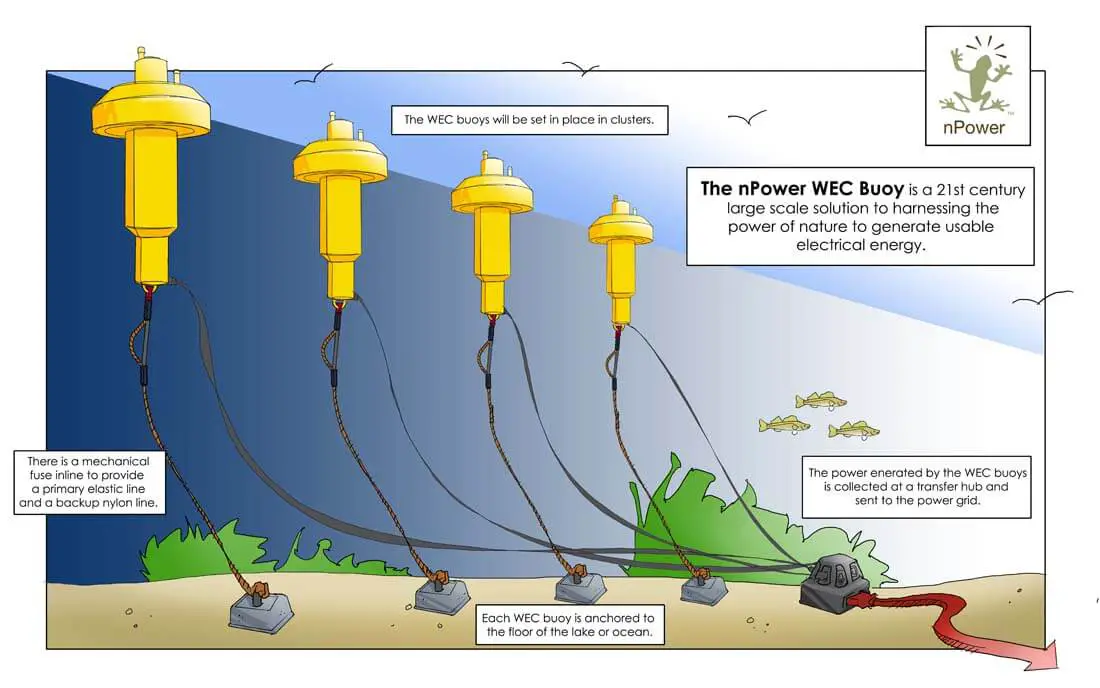
Today I thought it would be good for me to learn more about wave energy. As far as renewable energy sources go wave power gets considered as the new kid on the block. Many scientists also refer to wave energy as marine renewable energy[4].
It has had nowhere near the same levels of funding as solar or wind. And people in the field commonly joke that it is where wind power was 30 years ago.
I was surprised to find out that wave energy is considered a third-hand solar power. Sounds weird but here is how scientists explain it.
Most of the sunlight hits the surface of the Earth, and it warms the oceans. The warmed water warms the air above and then generates water vapor. As warm air rises, cooler air moves in to fill the void. In fact, the wind is second-hand solar energy. As wind rushes across open water, it generates waves.[1]
Don't let the 3rd hand fool you though. The wave energy industry has the potential to generate up to 2TW(Tera Watts) of power.
We can determine the power of a wave by the square of its amplitude and period of motion [1].
Since our tides, ocean waves and river currents contain kinetic and potential energy. We can harness this power to turn turbines. The turning of the turbines generates electricity. This electricity can help reduce our dependence on fossil fuels[4].
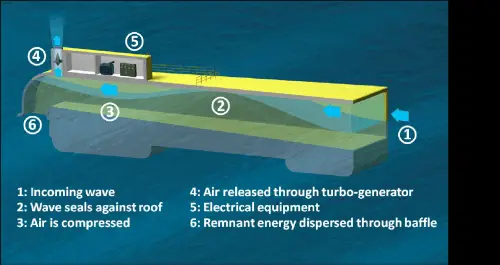
Another method is to use a floating buoy connected to a linear permanent magnet generator of a seabed-fixed device with a rope. The rope is kept tight by a spring under the magnet generator. Bobbing action from the buoy gets used to generate electricity[2].
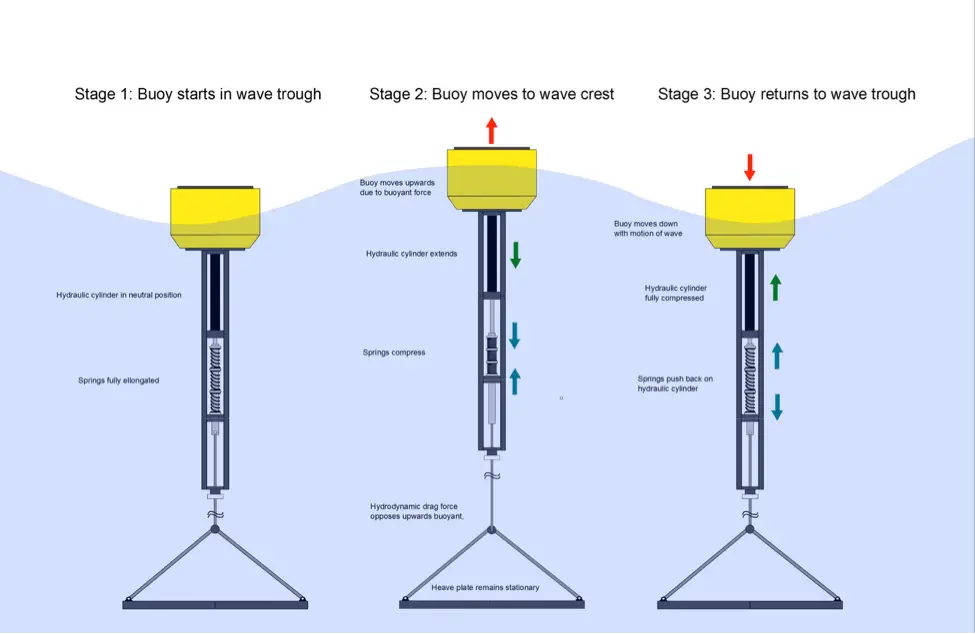
I have looked everywhere I could find, to compile the ultimate list of every advantage and disadvantage wave energy has. So keep reading and decide if wave power is something you think we should be investing our time and money.
Pros
- Green Energy
- Renewable
- Reliable and Consistent
- Large Energy Potential
- Efficient
- Can Get Setup Offshore No Land Required
- Minimum Visual Impact
- Low Operation Costs
- No Pollution/Spills
- Reduce Reliance on Foreign Oil / Fossil Fuels
- Shoreline Protection
- Highly Accessible Worldwide Potential
- Size Advantages
Cons
- Costs
- Effects on Marine Life
- Could Affect Fishing Industry
- Maintenance
- Power Generation Specific to Location
- Specific Wave Requirements for Power Generation
- Ocean Storms and Damaging Equipment
- Barrages May Restrict Access to Open Water
- Sedimentary Flow
- Few Implemented
- Difficult to Transmit Wave Energy
- Lack of Funding & Research
Advantages of Wave Energy
Check Out All The Different Pros of Wave Power
1. Green Energy
Since wave power does not release any emissions into the atmosphere, it gets considered as a source of green energy. By replacing fossil fuels with wave energy, we can reduce the amount of CO2 getting released into our atmosphere every year.
They have little chance of causing chemical pollution also. At most, wave energy converters will contain some lubricating or hydraulic oil, which will get carefully sealed from the environment[8].
2. Renewable
Wave energy will be available for as long as the tides continue to ebb and flow, and the rivers continue to run[4].
3. Reliable and Consistent
Waves a rarely interrupted and are almost always in motion. When compared to solar or wind wave power can generate electricity continuously from this motion.
4. Large Energy Potential
The approximated energy level from wave power energy could provide an approximated 2TW of power. 2TW is a massive amount of energy just waiting for us to harness.
5. Efficient
It gets estimated that having a wave farm taking up roughly half a square mile can generate over 30 MW of power. This amount of energy is enough to provide power to about 20,000 different residential homes[2].
Having the energy station further away from the shorelines helps increase the amount of power we can capture. But this comes with the added challenge of returning all this power to land. The further we have to transfer electricity, the more expensive the project becomes.
6. Can Get Setup Offshore No Land Required
Another added benefit to offshore wave energy is our ability to add equipment to harness wind energy as well. By placing wind turbines on top of our wave energy capturing devices, we can achieve significantly more power without increasing the surface area in use.
One issue with setting up these offshore is the additional difficulty for installing, maintaining, capturing, and retrieving the energy from these stations. All of these factors are much easier to manage when the system gets set up close to the coast[3].
7. Minimum Visual Impact
The wave energy converters generally get installed offshore and placed either on the surface of the water or fully submerged in it.
By placing the equipment away from land and low in the water, we can usually maintain the natural aesthetics of the area[5].
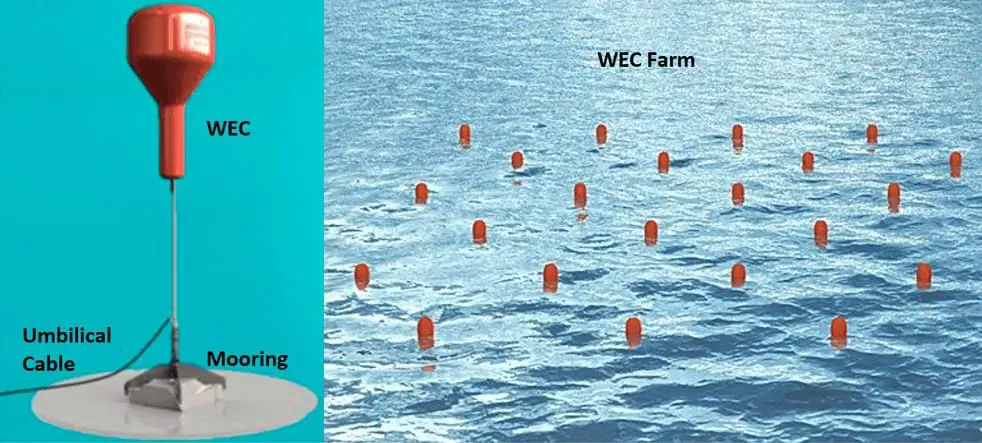
8. Low Operation Costs
After the installation of the wave energy converters and infrastructure are in place, the cost of maintaining the energy plant is low[5].
9. No Pollution/Spills
Since there is no fuel source used to generate the electricity(other than the waters kinetic energy) we do not have to worry about polluting the seas.
10. Reduce Reliance on Foreign Oil / Fossil Fuels
By using local renewable energy sources, we can reduce or dependency on fossil fuels and foreign oil. Many global factors outside anyone countries control can cause an increase in the cost of foreign fuels.
Being able to generate enough electricity from our resources helps to maintain our energy dependence which is extremely important from a country's security standpoint.
11. Shoreline Protection
One of the positive effects for the environment is when we capture the energy from waves is reduces the impact they have on our shoreline. By reducing the power of the wave, we reduce the amount of damage and corrosion of our coastline.
12. Highly Accessible Worldwide Potential
Since most of the world is covered with water, many countries can take advantage of the resource to help generate electricity.
13. Size Advantages
A single wave energy converters do not take up a large area. We can scale up a plants footprint and energy production by adding more units over time.
Disadvantages of Wave Energy
Check Out All The Different Cons of Wave Power
1. Costs
Compared to other renewable sources like hydro, solar, and wind power, the cost for us to create a wave power generating station is much higher.
2. Effects on Marine Life
One of the impacts caused by wave energy is interference with fish and their migration patterns.
One problem could be if marine mammals do not hear the devices. Then they might crash into them, or they could get caught in mooring cables(mooring cables are just used to anchor the device). Or another possibility is that marine species might alter there migration patterns or behavior to avoid interaction[6].
Physical structures in the water are known to attract marine life. Scientists call this the fish aggregation device effect since marine life view the devices as a reef.
The Electromagnetic fields used in wave-energy equipment can affect the feeding and orientation of some marine species. According to recent studies, salmon, crab, sturgeon, sharks, and rays are all extremely sensitive to these fields[6].
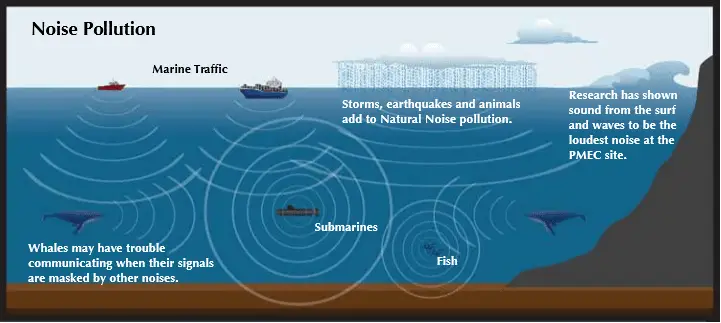
3. Could Affect Fishing Industry
Because wave energy power stations may alter the migrating habits of fish, we could see a negative effect on our fishing industry.
Equipment Breakdown/Malfunction
Since the wave energy converts get placed in such a harsh environment, the equipment could end up continually breaking down.
4. Maintenance
Depending on where all of the equipment gets located, maintenance of the equipment could reach high costs.
Having the machinery placed further from shore allows us to generate more electricity but also puts more wear and tear on the mechanism. It also makes it harder to repair the equipment when a failure happens.
5. Power Generation Specific to Location
The amount of power we can generate is directly dependent on the location used. By taking the square of the amplitude of the average wave and to the period of motion [1] we can understand the power of the wave.
6. Specific Wave Requirements for Power Generation
Only locations that have waves powerful enough to produce sufficient energy can justify the investment required.
7. Ocean Storms and Damaging Equipment
Strong ocean stormes can severely damage the wave convert technology. Especially devastating waves like a typhoon or hurricane could wipe out a wave power station in the blink of an eye.
Even without storms, the environment wave converters get placed in is a lot more volatile then capturing solar, geothermal, or wind energy.
8. Barrages May Restrict Access to Open Water
Having a large wave converter power station in the water prevents boats from using the area around them.
9. Sedimentary Flow
From what I could gather sedimentary flow is the movement of solid particles.
The flow of water naturally moves these particles around by tidal currents and waves, fulfilling necessary ecosystem processes.
As marine renewable energy devices get put in the water, the water flow will change around the device and alter sediment transport and distribution[9].
10. Few Implemented
So far, very few wave generating systems that have been put in use to generate electricity. So we still do not fully understand precisely how much damage they could cause to the environment.
11. Difficult to Transmit Wave Energy
Because most wave energy converts get setup away from shore infrastructure needs to be in place to effectively transmit the power generated.
The further we have to send the electricity, it gets harder and more expensive to connect the power to our energy grids.
The longer the distance will also introduce more possible locations of equipment failure.
12. Lack of Funding & Research
Because wave energy has not received as much funding as other sources the technology used is not as efficient. Advances in the tech are also happening at a much slower pace to other renewable energys[5].
Closing
While there are many positive aspects of wave energy, there are also several conditions that need to get taken into account.
Many of the negative aspects are still not fully understood and will require more funding in the sector.
Compared to our other renewable resources like geothermal, wind, and solar wave energy is just in its infancy. I found this surprising since the ocean can generate such massive amounts of energy.
You May Also Like
Dynamic Tidal Power: An Amazing Reliable Energy18 Pros and Cons of Hydroelectric Energy
[1]Akar, Sevda & Akbaş Akdoğan, Dilek. (2016). Environmental and Economic Impacts of Wave Energy:. 10.4018/978-1-5225-0440-5.ch013.
[2]Chen, Zhongxian & Yu, Haitao & Hu, Minqiang & Meng, Gaojun & Wen, Cheng. (2013). A Review of Offshore Wave Energy Extraction System. Advances in Mechanical Engineering. 2013. 10.1155/2013/623020.
[3]https://www.ducksters.com/science/environment/wave_and_tidal_energy.php
[4]https://www.nrcan.gc.ca/energy/energy-sources-distribution/renewables/marine-energy/what-marine-renewable-energy/7371
[5]http://www.renewablegreenenergypower.com/wave-energy-pros-and-cons/
[6]https://seagrant.oregonstate.edu/sites/seagrant.oregonstate.edu/files/sgpubs/onlinepubs/g14001.pdf
[7]https://www.sciencedirect.com/topics/engineering/barrage-system
[8]https://www.open.edu/openlearn/ocw/mod/oucontent/view.php?id=73764§ion=6
[9]https://tethys.pnnl.gov/interactions/changes-sediment-transport